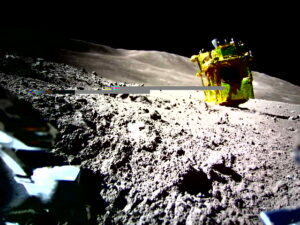Good night, SLIM
Lunar night has descended on JAXA’s Smart Lander for Investigating Moon, or SLIM, in the Shioli crater on the Moon. For the next 14 Earth days, temperatures will drop below 200 degrees Fahrenheit and the sky will be pitch dark. SLIM was not designed to survive those conditions, but JAXA will try to communicate with it again after sunrise in mid-February just in case it does.
SLIM is one of the new type of relatively inexpensive lunar landers that can achieve science and engineering results when sunlight shines on their solar cells to recharge the batteries and keep electronics warm. But they are not sufficiently robust to operate after sunset when temperatures plummet and the Sun doesn’t return for 14 days. Landers and rovers that do operate in those conditions, like those launched by the Soviet Union and United States in the 1960s and 1970s and China more recently, have radioisotope power sources.
SLIM is only the second of this new type of lander to successfully soft land on the Moon. India’s Chandrayaan-3 was the first last year. Like JAXA, the Indian Space Research Organisation (ISRO) hoped they might regain contact after sunlight returned, but it was not to be.
SLIM has already beaten the odds, though. The landing on January 19 Eastern Standard Time (January 20 in Japan) was a success even though SLIM is upside down with its nose in the lunar dirt because one of its engines failed during descent.


That’s a problem because most of the solar cells are on the top so sunlight could not recharge the battery until the sun angle changed days later.
JAXA was able to reestablish contact with SLIM and obtained more images from its Multi-Band Camera (MBC) before again losing contact last night.
Among other things, the 10-band MBC was able to complete the image it began on January 19 although the change in the sun’s angle means shadows fall differently.

A final image was taken as dusk fell. JAXA posted it on X.
Last night (1/31 ~ 2/1) we sent a command to switch on #SLIM’s communicator again just in case, but with no response, we confirmed SLIM had entered a dormant state. This is the last scene of the Moon taken by SLIM before dusk. #GoodAfterMoon #JAXA pic.twitter.com/V1iAUoxJFK
— 小型月着陸実証機SLIM (@SLIM_JAXA) February 1, 2024
JAXA said “MBC conducted two high-resolution 10-band observations of rocks and regolith at 13 observation locations using 333 full-scan images at different wavelengths” and they are now analzying the data to determine the chemical composition of the site. JAXA chose the Shioli Crater in the Sea of Nectar (Mare Nectaris) for SLIM’s landing because observations by an earlier Japanese orbiter, called either SELENE or Kaguya, detected the mineral olivine on the surface. That could hold clues to the Moon’s formation and evolution.
The next of these “new space” lunar landers is getting ready for launch by the U.S. company Intuitive Machines (IM). It is one of the participants in NASA’s Commercial Lunar Payload Services (CLPS) effort where NASA pays companies to deliver NASA science and technology payloads to the surface of the Moon. The companies design and build the landers and pay for a launch service provider. They are expected to find non-NASA customers to close the business case. NASA insists the purpose of the program is to help the private sector develop lunar landing capabilities, they understand the risks, and a 50-50 success rate for the program overall is OK.
The first CLPS mission, Peregrine, launched by Pittsburgh-based Astrobotic last month, suffered a propulsion failure. Houston-based IM’s lander, Odysseus, is completely different. The launch on a SpaceX Falcon 9 is currently targeted for “mid-February,” but IM, NASA and SpaceX decline to say when the 3-day launch window opens. IM does say that whichever of those days it might launch, it would land on February 22. If they can’t launch in February, another 3-day opportunity is in March.
User Comments
SpacePolicyOnline.com has the right (but not the obligation) to monitor the comments and to remove any materials it deems inappropriate. We do not post comments that include links to other websites since we have no control over that content nor can we verify the security of such links.